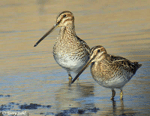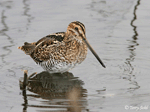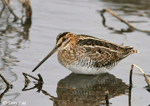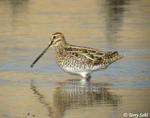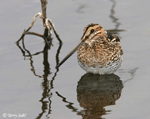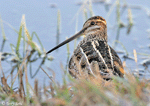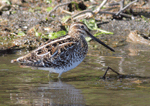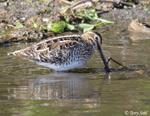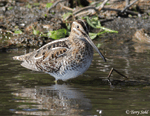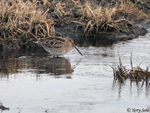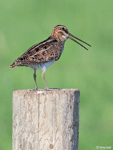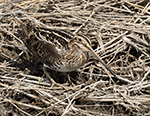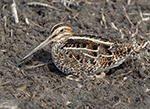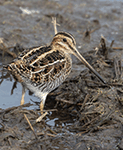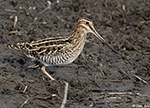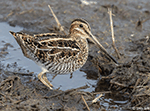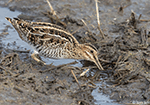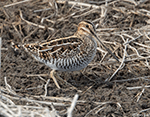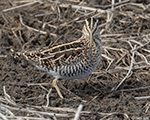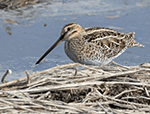| Length: 10 inches | Wingspan: 18 inches | Seasonality: Summer / Migrant |
| ID Keys: Long bill, longitudinal stripes on head, barring on flanks, short legs. | ||
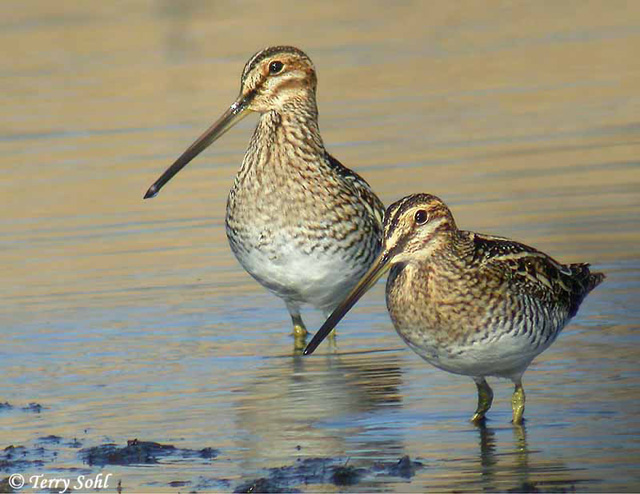 The Wilson's Snipe is a secretive, usually solitary bird of dense
freshwater marshes and brushy streamsides. During breeding season, they
are most often seen when disturbed, and flush in a quick, zig-zag flight.
However, they can be quite tame and approachable in migration through the state. The extremely long bill has a flexible tip which is used
to forage for prey as it probes in soft mud. They were formerly known as
the Common Snipe, but were split from a very similar Eurasian species after they
were found to be distinct.
The Wilson's Snipe is a secretive, usually solitary bird of dense
freshwater marshes and brushy streamsides. During breeding season, they
are most often seen when disturbed, and flush in a quick, zig-zag flight.
However, they can be quite tame and approachable in migration through the state. The extremely long bill has a flexible tip which is used
to forage for prey as it probes in soft mud. They were formerly known as
the Common Snipe, but were split from a very similar Eurasian species after they
were found to be distinct.
Habitat:
Freshwater marshes, brushy borders of ponds and streams.
Diet:
Takes large numbers of insects, insect larvae, and earthworms. Also crustaceans, mollusks, frogs, tadpoles, leeches, and some vegetation.
Behavior:
Uses its flexible and sensitive bill tip to probe in mud, capturing food underground. Will also collect food items from the ground, foliage, or the water's surface.
Nesting:
May and June. The nest is a shallow scrape on the ground, on which the female builds a shallow bowl of fine grasses and other vegetation. Two to four eggs are laid, with the female incubating the eggs. The young hatch after about 20 days.
Song:
Produces non-vocal "winnowing", a hooting trill in flight caused by vibrations of outer tail feathers.
- Click here to hear a harsh squawking call of a Wilson's Snipe disturbed and taking flight 1
- Click here to hear the rising, winnowing "song" of a Wilson's Snipe in flight 2
- Click here to hear a repetitive clear, single-note calling of a perched Wilson's Snipe 3
Migration:
Summers throughout much of Canada, Alaska, and the northern U.S. Winters from the southern half of the United States all the way through South America.
Interactive eBird map:
Click here to access an interactive eBird map of Wilson's Snipe sightings
Similar Species:
A unique looking bird, but with some related species that aren't that different at first glance:
- American Woodcock - In terms of structure and overall look, American Woodcock are easily the closest bird in appearance to a Wilson's Snipe. They're not all that likely to overlap in range, as Wilson's Snipe are birds of wetlands, while American Woodcocks are birds of upland forests and woodlands. In terms of appearance, American Woodcocks have a uniformly colored buffy belly and chest, while Wilson's Snipe have a clean white belly with flanks on the sides, and a buffy breast with spots. American Woodcock also have very short legs, even compared to a Wilson's Snipe.
- Long-Billed Dowitcher - The dowitcher species easily the most likely to be seen in South Dakota, with a long bill and plump body that is reminiscent of a Wilson's Snipe. A breeding-plumaged Long-billed Dowitcher has a rich rusty color underneath that easily differentiates it from the white-bellied Wilson's Snipe. In non-breeding plumage, have lighter plumage underneath that confuses identification, but it lacks the heavy barring on the flanks and breast that's found on a Wilson's Snipe. In any season, Long-billed Dowitchers have substantially longer legs than a Wilson's Snipe, while the eye of a Long-billed Dowitcher appears in a more "normal" position on the head, compared to the very high eye placement on the head of a Wilson's Snipe.
- Short-Billed Dowitcher. - See notes on the Long-billed Dowitcher above for identification keys, as Short-billed Dowitchers are very similar in appearance. Short-billed Dowitchers are found much less often in the interior of the country than Long-billed Dowitchers, and thus are less likely to be found in South Dakota in and around Wilson's Snipe.
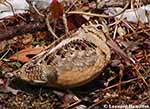 |
 |
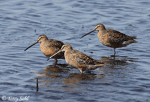 |
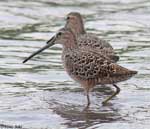 |
| American Woodcock | Long-billed Dowitcher | Long-billed Dowitcher | Short-billed Dowitcher |
Conervation Status:
Widespread and fairly common, although its secretive nature makes status somewhat unknown in areas. Loss of habitat has hurt populations in some areas, and there are indications that overall populations are in decline. However, they are still extremely numerous and are found over a wide geographic area. The IUCN considers the Wilson's Snipe to be a species of "least concern".
Further Information:
Photo Information:
April 12th, 2003 -- Madison Waterfowl Production Area -- Terry L. Sohl
Additional Photos:
Click on the image chips or text links below for additional, higher-resolution Wilson's Snipe photos.
Audio File Credits:
- 1Paul Marvin - Recorded in Hidalgo County, Texas on December 17th, 2017. Original file and recording from xeno-canto.
- 2Steve Hampton - Recorded near Nome Alaska on May 27th, 2018. Original file and recording from xeno-canto.
- 3Bruce Lagerquist - Recorded in Kittitas County, Washington on April 21st, 2019. Original file and recording from xeno-canto.
| Click on the map below for a higher-resolution view |
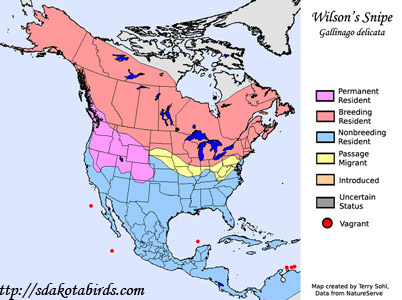 |
| South Dakota Status: Common migrant statewide. Uncommon summer breeding resident. Local in winter. |
Additional Wilson's Snipe Photos
Click for a higher-resolution version of these photos
